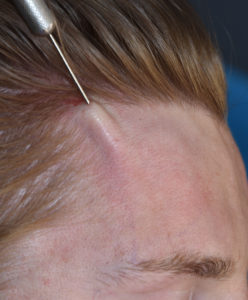The shape of the forehead can be augmented using multiple techniques. The two most common and successful methods are the use of bone cements and a custom 3D implant. Each of these two approaches can be very effective although the custom implant approach can be done using a smaller incision with an assured smooth and preoperatively predicted shape.
While these larger augmentation approaches are justified since they cover the entire forehead, smaller amounts of forehead augmentation may be able to be treated in a less invasive fashion. This makes an injectable approach to smaller forehead augmentations as both appealing and an actual treatment consideration.

While fat as a donor material is usually ready available in most patients and can injected through undetectable 22 gauge needle entrance sites for the cannula, it is not a completely reliable forehead augmentation material. The retention of the volume provided by fat injections can never be completely assured. While the fat injections are almost always placed above the periosteum at the galeal-subcutaneous level, that is not a tissue plane that is replete with natural fat…thus having a negative variable for injected fat graft survival.
But for ‘spot’ forehead augmentation areas, where more invasive techniques may not be warranted or desired, injectable fat grafting is a viable autologous option
Dr. Barry Eppley
Indianapolis, Indiana


